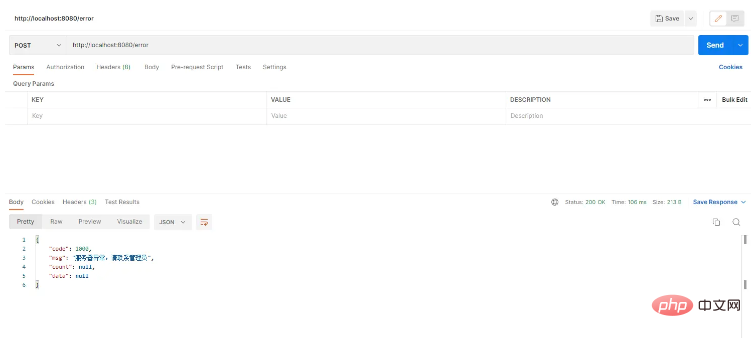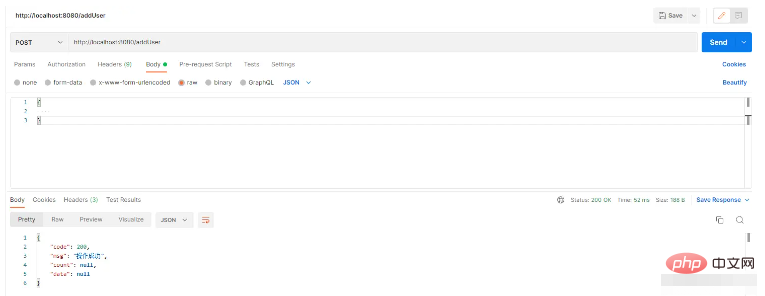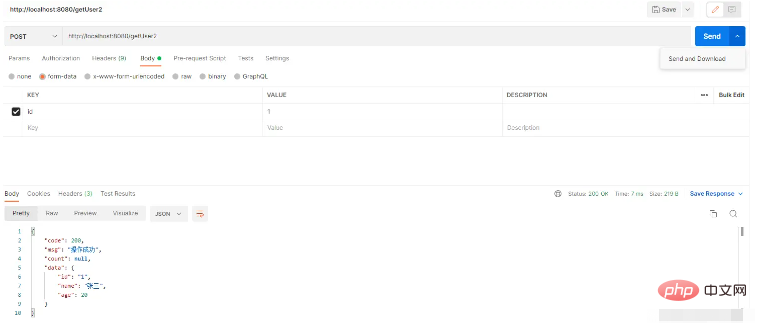How to handle SpringBoot unified return format
Background
I believe that most back-end developers need to interface with the front-end in daily development. Of course, if you do the front-end and back-end by yourself, you can play whatever you want, but we still have to Achieve certain standardization. In projects with front-end and back-end separation, the format returned by the back-end must be friendly and fixed, and cannot be changed frequently, otherwise it will bring a lot of workload to the front-end developers.
SpringBoot Controller common return format
String
@PostMapping("/test")
public String test(){
return "Hello World";
}postman call result:

Custom object
Normal return
@PostMapping("/getUser")
public ActionResult getUser(){
User user = new User();
user.setId(UUID.randomUUID().toString());
user.setName("MrDong");
user.setAge(20);
return ActionResult.defaultOk(user);
}postman call result:

Error return
@PostMapping("/error")
public ActionResult error(){
return ActionResult.defaultFail(1000,"服务器异常,请联系管理员");
}Postman call result:

Define the return object
I define two ActionResult objects to encapsulate the return value , which can be modified according to the actual situation of your company:
package com.wxd.entity;
import com.wxd.enums.ResultCodeEnum;
import lombok.Data;
/**
* @ClassName ActionResult
* @Description 统一返回值封装
* @Author Mr Dong
* @Date 2022/7/26 14:51
*/
@Data
public class ActionResult {
private Integer code;
private String msg;
private Integer count;
private Object data;
public static ActionResult defaultOk(Integer code, String msg, Integer count, Object data) {
return new ActionResult(code, msg, count, data);
}
public static ActionResult defaultOk(Integer count, Object data) {
return new ActionResult(ResultCodeEnum.RC200, count, data);
}
public static ActionResult defaultOk(Object data) {
return new ActionResult(ResultCodeEnum.RC200, null, data);
}
public static ActionResult defaultOk() {
return new ActionResult(ResultCodeEnum.RC200);
}
public static ActionResult defaultFail() {
return new ActionResult(ResultCodeEnum.RC999);
}
public static ActionResult defaultFail(Integer code, String msg) {
return new ActionResult(code, msg);
}
public static ActionResult defaultFail(ResultCodeEnum resultCodeEnum) {
return new ActionResult(resultCodeEnum);
}
public ActionResult(Integer code, String msg, Integer count, Object data) {
this.code = code;
this.msg = msg;
this.count = count;
this.data = data;
}
public ActionResult(Integer code, String msg) {
this.code = code;
this.msg = msg;
}
public ActionResult(ResultCodeEnum resultCodeEnum) {
this.code = resultCodeEnum.getCode();
this.msg = resultCodeEnum.getMessage();
}
public ActionResult(ResultCodeEnum resultCodeEnum, Integer count, Object data) {
this.code = resultCodeEnum.getCode();
this.msg = resultCodeEnum.getMessage();
this.count = count;
this.data = data;
}
}Define status enumeration
package com.wxd.enums;
/**
* @author wxd
* @version V1.0
* @description ResultCodeEnum
* @date 2022/8/10 13:35
**/
public enum ResultCodeEnum {
/**
* 操作成功
*/
RC200(200, "操作成功"),
/**
* 未授权
*/
RC401(401, "用户未授权"),
/**
* 请求被禁止
*/
RC403(403, "请求被禁止"),
/**
* 服务异常
*/
RC500(500, "服务器异常,请联系管理员"),
/**
* 操作失败
*/
RC999(999, "操作失败"),
RC1001(1001, "用户名密码错误"),
RC1002(1002, "未授权的资源"),
RC1003(1003, "未授权的资源"),
RC1004(1004, "缺少请求参数异常"),
RC1005(1005, "缺少请求体参数异常"),
RC1006(1006, "参数绑定异常"),
RC1007(1007, "方法参数无效异常");
private Integer code;
private String message;
ResultCodeEnum(Integer code, String message) {
this.code = code;
this.message = message;
}
public Integer getCode() {
return code;
}
public String getMessage() {
return message;
}
}Unified processing of return values and exceptions
Implementation principle: You need to implement the ResponseBodyAdvice interface provided by SpringBoot , complete the encapsulation of unified return values and exception handling. After implementing this interface, you only need to return the object directly when the Controller returns. Some that do not need a return value can directly return void.
package com.wxd.advice;
import com.wxd.entity.ActionResult;
import com.wxd.enums.ResultCodeEnum;
import lombok.extern.slf4j.Slf4j;
import org.springframework.core.MethodParameter;
import org.springframework.http.HttpStatus;
import org.springframework.http.MediaType;
import org.springframework.http.converter.HttpMessageNotReadableException;
import org.springframework.http.server.ServerHttpRequest;
import org.springframework.http.server.ServerHttpResponse;
import org.springframework.validation.BindException;
import org.springframework.web.bind.MethodArgumentNotValidException;
import org.springframework.web.bind.MissingServletRequestParameterException;
import org.springframework.web.bind.annotation.ExceptionHandler;
import org.springframework.web.bind.annotation.ResponseStatus;
import org.springframework.web.bind.annotation.RestControllerAdvice;
import org.springframework.web.servlet.mvc.method.annotation.ResponseBodyAdvice;
/**
* @version: V1.0
* @author: wxd
* @description: 全局异常处理以及返回值的统一封装
* @Date 2022/7/26 16:24
*/
@RestControllerAdvice(value = "com.wxd.controller")
@Slf4j
public class ResponseAdvice implements ResponseBodyAdvice {
@Override
public boolean supports(MethodParameter methodParameter, Class aClass) {
return true;
}
/**
* 统一包装
*
* @param o
* @param methodParameter
* @param mediaType
* @param aClass
* @param serverHttpRequest
* @param serverHttpResponse
* @return
*/
@Override
public Object beforeBodyWrite(Object o, MethodParameter methodParameter, MediaType mediaType, Class aClass, ServerHttpRequest serverHttpRequest, ServerHttpResponse serverHttpResponse) {
/**
* String、ActionResult不需要再包一层(不想包一层ActionResult对象的可以在这里把这个对象过滤掉)
*/
if (o instanceof String || o instanceof ActionResult) {
return o;
}
return ActionResult.defaultOk(o);
}
/**
* 系统内部异常捕获
*
* @param e
* @return
*/
@ResponseStatus(HttpStatus.INTERNAL_SERVER_ERROR)
@ExceptionHandler(value = Exception.class)
public Object exceptionHandler(Exception e) {
log.error("系统内部异常,异常信息", e);
return ActionResult.defaultFail(ResultCodeEnum.RC500);
}
/**
* 忽略参数异常处理器;触发例子:带有@RequestParam注解的参数未给参数
*
* @param e 忽略参数异常
* @return ResponseResult
*/
@ResponseStatus(HttpStatus.BAD_REQUEST)
@ExceptionHandler(MissingServletRequestParameterException.class)
public Object parameterMissingExceptionHandler(MissingServletRequestParameterException e) {
log.error("缺少Servlet请求参数异常", e);
return ActionResult.defaultFail(ResultCodeEnum.RC1004);
}
/**
* 缺少请求体异常处理器;触发例子:不给请求体参数
*
* @param e 缺少请求体异常
* @return ResponseResult
*/
@ResponseStatus(HttpStatus.BAD_REQUEST)
@ExceptionHandler(HttpMessageNotReadableException.class)
public Object parameterBodyMissingExceptionHandler(HttpMessageNotReadableException e) {
log.error("参数请求体异常", e);
return ActionResult.defaultFail(ResultCodeEnum.RC1005);
}
/**
* 统一处理请求参数绑定错误(实体对象传参);
*
* @param e BindException
* @return ResponseResult
*/
@ResponseStatus(HttpStatus.BAD_REQUEST)
@ExceptionHandler(BindException.class)
public Object validExceptionHandler(BindException e) {
log.error("方法参数绑定错误(实体对象传参)", e);
return ActionResult.defaultFail(ResultCodeEnum.RC1006);
}
/**
* 统一处理请求参数绑定错误(实体对象请求体传参);
*
* @param e 参数验证异常
* @return ResponseResult
*/
@ResponseStatus(HttpStatus.BAD_REQUEST)
@ExceptionHandler({MethodArgumentNotValidException.class})
public Object parameterExceptionHandler(MethodArgumentNotValidException e) {
log.error("方法参数无效异常(实体对象请求体传参)", e);
return ActionResult.defaultFail(ResultCodeEnum.RC1007);
}
}void No return value

Have return value

The above is the detailed content of How to handle SpringBoot unified return format. For more information, please follow other related articles on the PHP Chinese website!

Hot AI Tools

Undresser.AI Undress
AI-powered app for creating realistic nude photos

AI Clothes Remover
Online AI tool for removing clothes from photos.

Undress AI Tool
Undress images for free

Clothoff.io
AI clothes remover

Video Face Swap
Swap faces in any video effortlessly with our completely free AI face swap tool!

Hot Article

Hot Tools

Notepad++7.3.1
Easy-to-use and free code editor

SublimeText3 Chinese version
Chinese version, very easy to use

Zend Studio 13.0.1
Powerful PHP integrated development environment

Dreamweaver CS6
Visual web development tools

SublimeText3 Mac version
God-level code editing software (SublimeText3)

Hot Topics
 1386
1386
 52
52
 How Springboot integrates Jasypt to implement configuration file encryption
Jun 01, 2023 am 08:55 AM
How Springboot integrates Jasypt to implement configuration file encryption
Jun 01, 2023 am 08:55 AM
Introduction to Jasypt Jasypt is a java library that allows a developer to add basic encryption functionality to his/her project with minimal effort and does not require a deep understanding of how encryption works. High security for one-way and two-way encryption. , standards-based encryption technology. Encrypt passwords, text, numbers, binaries... Suitable for integration into Spring-based applications, open API, for use with any JCE provider... Add the following dependency: com.github.ulisesbocchiojasypt-spring-boot-starter2. 1.1Jasypt benefits protect our system security. Even if the code is leaked, the data source can be guaranteed.
 How SpringBoot integrates Redisson to implement delay queue
May 30, 2023 pm 02:40 PM
How SpringBoot integrates Redisson to implement delay queue
May 30, 2023 pm 02:40 PM
Usage scenario 1. The order was placed successfully but the payment was not made within 30 minutes. The payment timed out and the order was automatically canceled. 2. The order was signed and no evaluation was conducted for 7 days after signing. If the order times out and is not evaluated, the system defaults to a positive rating. 3. The order is placed successfully. If the merchant does not receive the order for 5 minutes, the order is cancelled. 4. The delivery times out, and push SMS reminder... For scenarios with long delays and low real-time performance, we can Use task scheduling to perform regular polling processing. For example: xxl-job Today we will pick
 How to use Redis to implement distributed locks in SpringBoot
Jun 03, 2023 am 08:16 AM
How to use Redis to implement distributed locks in SpringBoot
Jun 03, 2023 am 08:16 AM
1. Redis implements distributed lock principle and why distributed locks are needed. Before talking about distributed locks, it is necessary to explain why distributed locks are needed. The opposite of distributed locks is stand-alone locks. When we write multi-threaded programs, we avoid data problems caused by operating a shared variable at the same time. We usually use a lock to mutually exclude the shared variables to ensure the correctness of the shared variables. Its scope of use is in the same process. If there are multiple processes that need to operate a shared resource at the same time, how can they be mutually exclusive? Today's business applications are usually microservice architecture, which also means that one application will deploy multiple processes. If multiple processes need to modify the same row of records in MySQL, in order to avoid dirty data caused by out-of-order operations, distribution needs to be introduced at this time. The style is locked. Want to achieve points
 How to solve the problem that springboot cannot access the file after reading it into a jar package
Jun 03, 2023 pm 04:38 PM
How to solve the problem that springboot cannot access the file after reading it into a jar package
Jun 03, 2023 pm 04:38 PM
Springboot reads the file, but cannot access the latest development after packaging it into a jar package. There is a situation where springboot cannot read the file after packaging it into a jar package. The reason is that after packaging, the virtual path of the file is invalid and can only be accessed through the stream. Read. The file is under resources publicvoidtest(){Listnames=newArrayList();InputStreamReaderread=null;try{ClassPathResourceresource=newClassPathResource("name.txt");Input
 Comparison and difference analysis between SpringBoot and SpringMVC
Dec 29, 2023 am 11:02 AM
Comparison and difference analysis between SpringBoot and SpringMVC
Dec 29, 2023 am 11:02 AM
SpringBoot and SpringMVC are both commonly used frameworks in Java development, but there are some obvious differences between them. This article will explore the features and uses of these two frameworks and compare their differences. First, let's learn about SpringBoot. SpringBoot was developed by the Pivotal team to simplify the creation and deployment of applications based on the Spring framework. It provides a fast, lightweight way to build stand-alone, executable
 How to implement Springboot+Mybatis-plus without using SQL statements to add multiple tables
Jun 02, 2023 am 11:07 AM
How to implement Springboot+Mybatis-plus without using SQL statements to add multiple tables
Jun 02, 2023 am 11:07 AM
When Springboot+Mybatis-plus does not use SQL statements to perform multi-table adding operations, the problems I encountered are decomposed by simulating thinking in the test environment: Create a BrandDTO object with parameters to simulate passing parameters to the background. We all know that it is extremely difficult to perform multi-table operations in Mybatis-plus. If you do not use tools such as Mybatis-plus-join, you can only configure the corresponding Mapper.xml file and configure The smelly and long ResultMap, and then write the corresponding sql statement. Although this method seems cumbersome, it is highly flexible and allows us to
 How SpringBoot customizes Redis to implement cache serialization
Jun 03, 2023 am 11:32 AM
How SpringBoot customizes Redis to implement cache serialization
Jun 03, 2023 am 11:32 AM
1. Customize RedisTemplate1.1, RedisAPI default serialization mechanism. The API-based Redis cache implementation uses the RedisTemplate template for data caching operations. Here, open the RedisTemplate class and view the source code information of the class. publicclassRedisTemplateextendsRedisAccessorimplementsRedisOperations, BeanClassLoaderAware{//Declare key, Various serialization methods of value, the initial value is empty @NullableprivateRedisSe
 How to get the value in application.yml in springboot
Jun 03, 2023 pm 06:43 PM
How to get the value in application.yml in springboot
Jun 03, 2023 pm 06:43 PM
In projects, some configuration information is often needed. This information may have different configurations in the test environment and the production environment, and may need to be modified later based on actual business conditions. We cannot hard-code these configurations in the code. It is best to write them in the configuration file. For example, you can write this information in the application.yml file. So, how to get or use this address in the code? There are 2 methods. Method 1: We can get the value corresponding to the key in the configuration file (application.yml) through the ${key} annotated with @Value. This method is suitable for situations where there are relatively few microservices. Method 2: In actual projects, When business is complicated, logic




